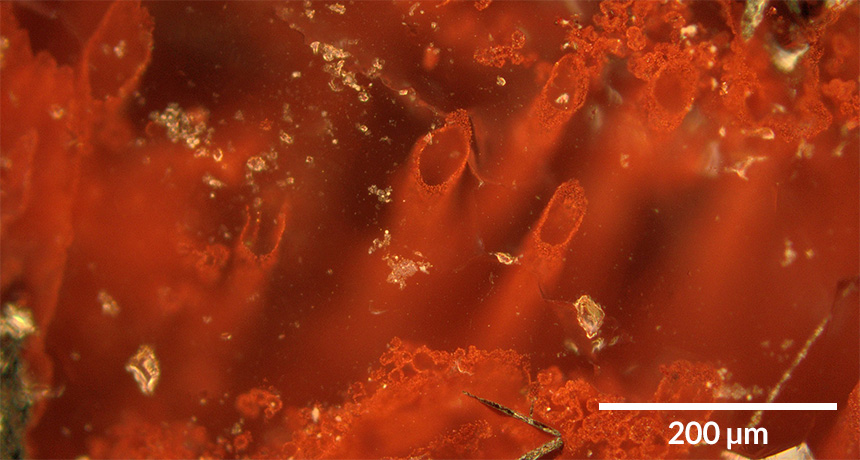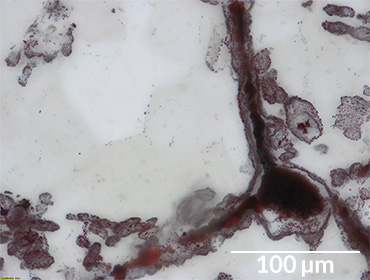Fossils offer new candidate for earliest life
They appear to be remnants of microbes from some 4 billion years ago, when Earth was very young

These microscopic tubes of hematite — an ore of iron — come from rocks left over from ancient hydrothermal vents. They appear to be remnants of early microbes.
M. Dodd
By Meghan Rosen
Scientists have uncovered tiny, iron-rich fossils that come from the depths of an ancient ocean. They were unearthed in Quebec, Canada, and date to somewhere between 4.28 billion and 3.77 billion years ago. Back then, Earth was still a baby.
These tiny structures appear to be remnants of microbes that once lived around hydrothermal vents. These are structures that spew scalding hot water from the seafloor. The tiny tube-like vents might turn out to be ancient cradles of life.
“In a nutshell, what we’ve found are the oldest microfossils on Earth,” says Matthew Dodd. He’s a biogeochemist — someone who studies the chemicals in ancient rock that may point to life. Dodd works in England at University College London.
He and his colleagues described the fossils March 1 in Nature.
But not everyone is ready to accept their conclusion. Martin Van Kranendonk is one of the doubters. He’s an astrobiologist at the University of New South Wales in Sydney. If Dodd’s structures truly are remnants of microbes, “it’s fantastic. I love it,” he says. But, he adds, “There’s just not definitive proof that any of the textures or the minerals or features they have is unique of life.”
Why identifying early life is challenging
Claims of early life often provoke controversy. Dodd admits that his team’s assessment may be hard to accept: “These are big claims — these are our origins.” Contributing to the problem is that he and others who hunt signs of early life usually have little to work with.
It’s not like they’re looking at big dinosaur bones. The early organisms were microbes — really, really tiny. What’s more, many familiar hallmarks of life may have been stripped away from the remains of billions-of-years-old microbes. And then there’s the extreme heat and pressure to which Earth’s oldest rocks would have subjected over the eons. These could have cooked and squashed any remnants of life beyond recognition.
So if scientists can’t find molded impressions of some long-gone organism, what do they use? Clues. They perform chemical tests, for instance. They analyze rock patterns and textures, some of which may be truly microscopic. Afterward, they put the clues together, hoping to amass enough evidence to determine whether the rocks point to ancient life — or not.
Last year, Van Kranendonk and his coworkers reported evidence of ancient microbial structures. They came from 3.7-billion-year-old rocks in Greenland.
Those structures were stromatolites (Strow-MAT-uh-lytes), microfossils that came from an entirely different environment. Although possibly similar in age to Dodd’s, these fossils came from shallow seas. And unlike the deep sea vents, the stromatolites might have been touched by sunlight.
So microbes may have been thriving in two very different environments, both quite early in Earth’s history. And that would mean that life arose and evolved quickly, Dodd says. It might mean that “life didn’t really struggle to get a foothold.”
What the latest study found

Dodd’s team looked at rocks made of jasper. These seem to be leftovers of matter that long ago belched out of hydrothermal vents and then rained down on the seafloor. Dodd’s team spotted narrow tubes and filaments of an iron-rich mineral, known as hematite (HE-muh-tyte). Those filaments resemble ones that today’s bacteria make, Dodd says. Specks of iron clung to the sticky surface of the ancient microbes, he says. This would have formed a kind of armored coat that preserved the organisms’ shapes.
Other clues of early life also turned up. These included carbon minerals, such as apatite, that had earlier been linked to biological activity.
Taken together, all of those hints seemed to add up. Aside from life, he argues, “There’s no other mechanism that can explain all of these observations.”
Biology is indeed one possible explanation, says Abigail Allwood. She’s an astrobiologist at NASA’s Jet Propulsion Laboratory in Pasadena, Calif. “But the evidence could equally be interpreted as non-biological.”
Each line of evidence, she points out, reflects processes that could have actually occurred at different times. When taken together, those clues may seem to add up the remains of a living organism — even if that’s not what caused it. “You can’t just wave your arms and say this all happened together,” she argues.
Paleobiologist David Wacey works at the University of Western Australia in Crawley. He agrees that “the individual lines of chemical evidence are not particularly strong.” But combined with the microstructures, he thinks that Dodd’s team offers a “pretty convincing biological scenario.”
Wacey expects the Quebec rocks to now be pored over in more detail. “There will, no doubt, be arguments,” he says. But the study may revitalize the case for hydrothermal vents as a potential birthplace for life.







